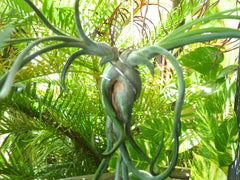How To Take Care of Air Plants
Air plants, also known as Tillandsia, are a kind of epiphytes. The plants are well known for their thick, silvery foliage and vivid flowers, but these unique plants don’t require any soil to grow, however, they still require a place to hang-out. Unlike traditional plants, air plants are not parasites, meaning they do not get their nutrients from their host. Even though they have roots, the roots are used for anchoring rather than getting nutrients. These plants get all their water and nutrient requirements from absorption through their leaves.

When grown indoors, these plants make a striking addition to your indoor décor. They have different appearances and can be used to decorate different rooms in a house. Just like any other house plant, these plants require some care to thrive.
So how do we take care of Air Plants...
Water Needs
Water is crucial to the survival of air plants. When they receive the water in sufficient quantities, their silvery leaves are very beautiful. You need to mist them every few days, especially if they're exposed to dry indoor environments or drying winds.
These plants also require regular deep-water hydration, especially if there are signs of drying out. To give an air plant a bath, submerge the whole plant in clean, room-temperature water for about 30 minutes. Make sure the flowers are not submerged or they will die prematurely. Shake off any excess moisture, let dry and then return your plant to their home. Soak your plants once every month.
The plants are very sensitive to the chemicals in water. if you use tap water, let it sit overnight so the chemicals evaporate. Water with a PH higher than 8 or softened water which is high in salt is deadly to these plants. Bottled water works well and rain water is even more effective.
Lighting
Air plants require indirect or partial sunlight to grow. When indoors, keep them no more than 10 feet from the window. A simple fluorescent light will also work well. However, be sure not let the plant stay exposed to direct sun for too long, as it might suffer from leaf burn.
Dealing with Pups
These plants produce beautiful, long-lasting flowers, before producing pups (baby air plants). The plants will grow 2-8 pups. The pups can be left on the parent plant to give a fuller appearance, or can be removed to create separate plants. If you want to remove the pups, make sure they are at least 1/2 the parent’s size. This ensures the pups are strong enough to live on their own.
Grooming
Air plants rarely require pruning thanks to the natural dense, tidy growth pattern. However, they require occasional grooming to restore their beautiful appearance. Remove all dead, dry or brown leaves from your air plant. Cut back any dead or brown tips until what is left is a healthy growth. Trim any unsightly growth of, if you wish, roots from your plant. When pruning use sharp pruning shears. I like to use a small pair of surgical scissors.
Feeding
Air plants in captivity need minimal supplemental nutrients to flourish. Feeding these plants differs from many others because of the epiphytic nature. Their own roots are very sensitive and can't absorb urea like the terrestrial plants. You can feed them with urea-free fertilizer with N-P-K analysis of '30-10-10'. Orchid fertilizer works well when diluted. Mix this fertilizer at ¼ the recommended strength. Dissolve the fertilizer in one gallon of water. Mist the fertilizer solution onto the plant’s leaves until they’re saturated, or just add to the monthly soaking bath.
Potential problems
Air plants experience few problems. They don’t suffer from chronic diseases and insects and pests rarely bother them because the do not grow in soil. For a healthy air plant, the entire plant requires access to free air. Grow the plants mounted on some wood or any other organic material, or place the plants on top of stones or sand, like in our Terrarium Globes. Avoid putting your plants vessels that allow water to collect, as this will surely kill you plants.
How to water Air Plants
Although air plants don’t have the typical roots that supply nutrients as most plants do, and therefore require no soil, they still need water to survive. In the wild, air plants are able to absorb moisture and nutrients from the air, but when moved indoors, there is not enough moisture to keep them healthy.
Here is an easy 2-step water regimen that will keep your air plants healthy:
1) Fill a fine mister with either bottled water or tap water. If you use tap water, let the water sit overnight in an open container so that all the chemicals have time to evaporate.
Mist your plants about twice a week to start. If your home is extremely dry, mist more often. Don’t be timid, a good mist is healthy. You can either remove them from their container, or just mist them in place. Either way, a fine mist twice a week usually works fine for basic maintenance.

2) One a month, give your air plants an opportunity to completely rehydrate. To do this, carefully remove your plants (if possible) from the container and place then into a soaking bath for about ½ hour. Remove your plants, shake off the excess water and then let them dry before placing them back into their container. Be sure to use bottled or aged tap water. Never use distilled water. It will kill your plants.
Be sure to water or soak your plants in the morning or early afternoon so they have time to completely dry. If placed into a contained wet, your plants may rot from the bottom and die.
If your plants are flowering, be careful to keep the blooms dry. Watering the flowers will shorten the bloom life.

Fresh Decorating Ideas for Air Plants
It doesn’t take much effort to make your air plants look great.
But if you’re looking to go above and beyond, there’s no shortage of inspiration sources. Zenaida Sengo, a San Francisco gardener and interior designer, has published a book on just that topic.
In Air Plants: The Curious World of Tillandsias, published in paperback Sept. 30, Sengo and photographer Caitlin Atkinson explore creative ways to make your home look its best using simple design projects. “Known for their spiky shape and extremely low-maintenance needs, they are growing increasingly popular for crafting, design, and décor,” they write.

The book includes six step-by-step projects, “including a wood mount and several unique terrariums.” The book is available on Amazon for $14.25.
How Do Air Plants Reproduce

After flowering, most air plants start the reproduction cycle by producing “pups”, which typically start growing around the base of the air plant. When the "pups" grow to about 1/2 size of the parent, you have 2 cool options:
1) remove the "pup" and let your new plant grow, flower and reproduce again
2) leave the "pup" attached, and you'll soon have a beautiful cluster growing, which will continue to flower and produce new "pups"
It's very enjoyable to watch the growing cycle. Each specie of air plant reproduces somewhat differently. if you have kids, this is very educational and fun to watch. PLUS... you are purifying the air you breath. Air plants are one of the best natural air cleaners of all plant species.
So what exactly is an Air Plant?
The Air Plant, also know as Tillandsia, might just be the ultimate urban houseplant.


The Tillandsia, more commonly referred to as Air Plants, are unique plants from the Bromeliad family. They are colorful, easy to care for, exotic and very affordable.
Plantstr has been selling Air Plants successfully for many years and they are becoming more popular every day. With Air Plants, the care is minimal, they don’t attract insects and they are perfect for small urban settings and apartments.
There are currently around 500 various types of Tillandsias, most of which are native to Central America, South America and Mexico. They range in size from a few inches to as large as 4 feet across.
Once Air Plants mature and flower, they produce babies, also know as pups, and can have as many as 12. Once a mother plant flowers, it will never flower again, slowly dying within a few years. During this time, the pups are getting all of the nutrients from the mother plant. Eventually, the pups will flower and the cycle will continue.
Another interesting feature about Air Plants is that they clean the air. In fact, a few years ago, there was a study that showed that the Tillandsias can clean the air and remove more airborne particles than any other plant on earth. This is also how they get their nourishment.
Tillandsias are also one of the most forgiving and easy to care for plants available, although the watering requirements can be a little tricky. The best option is to mist them once a week or you can run the plant under a faucet. If the plant starts to dry out, submerge it overnight to rehydrate it.
For more information on how to care for your Air Plants you can visit http://www.plantstr.net/pages/air-plant-care









 Plantstr is about making you feel good about yourself and the place you live. Beautiful, exotic flowering
Plantstr is about making you feel good about yourself and the place you live. Beautiful, exotic flowering 



